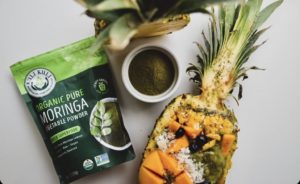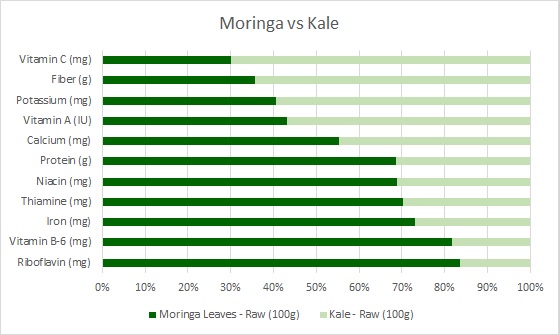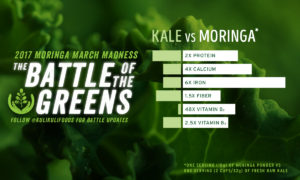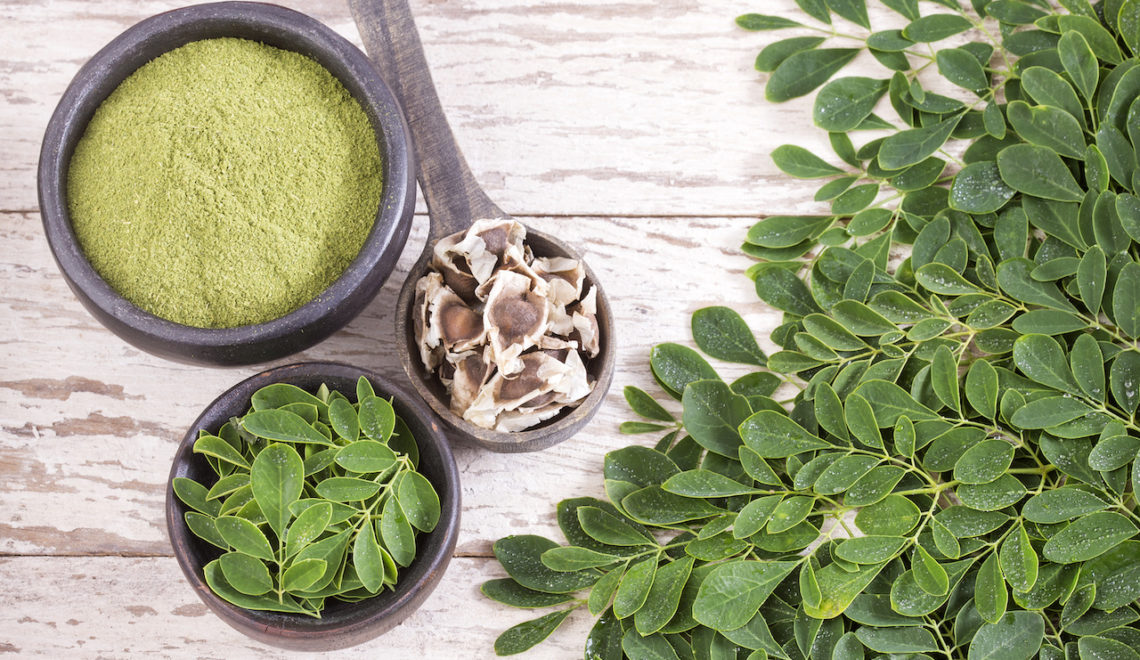While you may have only seen the word “moringa” in the last few years, how much do you know about it? How does the superfood moringa compare to other superfoods? Remember back to 2014, when kale was becoming popular on every brunch menu and new cookbook? In 2014, we launched the Battle of the Supergreens, a lively series where we compare superfoods with each other. Our first “battle” was Moringa vs. Kale!
Dubbed an ultra nutrient-dense superfood, with many even calling it the most nutritious plant in the world, it’s no wonder that the leafy vegetable has gained so much attention. Don’t ignore the hype, because kale really is nutrient dense with a vast array of vitamins, minerals, and even protein. But how does the lesser-known superfood moringa stack up against nutritional heavyweight kale?
The Battle of the Greens Begins: Moringa vs. Kale
Kale is a leafy green vegetable closely related to brussell sprouts, broccoli, and cauliflower. It is found in a wide variety of places around the world and is especially prevalent in Europe and the United States. Kale is also widely available in most grocery stores. A versatile food, Kale can be served steamed, boiled, or raw.
Nutritionally, kale is known for its high levels of iron, calcium, beta carotene, and vitamin C. It’s also a good source of plant protein. Furthermore, the carotenoids and phytochemicals in kale may protect against certain diseases, including cancer.
Moringa: The Underdog?
In the world of superfoods, kale’s established role as the go-to green superfood often overshadows moringa. However, moringa is becoming more and more popular and deserves much more attention. If you aren’t familiar, moringa is a slender tree with nutrient dense leaves.

Moringa Pineapple Smoothie Recipe and photo by @notyouravgcupofjones.
Moringa leaves can be added to soups, curries, pasta sauces, used to make tea, or tossed in a salad. Kuli Kuli uses dried moringa leaves to make our shelf-stable moringa superfood powder. Add moringa powder to a wide variety of different dishes for an easy boost to nutrition. If you’d like some delicious examples, be sure to check out our library of moringa powder recipes.
In several areas the nutritional profile of kale and moringa contain several similarities. Moringa also contains high levels of iron, calcium, beta-carotene, vitamins B and C, and is a complete plant protein with all nine essential amino acids. Furthermore, unlike kale, moringa contains three flavonoids which have been studied extensively for their role in protecting against heart disease and cancer, as well as having anti-inflammatory properties. Read here for more information about moringa’s anti-inflammatory properties.
Moringa vs Kale: The Breakdown
To break things down visually, here is a comparison between the two leafy greens in their raw form.
A side-by-side comparison shows that moringa provides a better source of plant protein by more than a factor of two. Moringa is also about 25% higher in Calcium. Kale takes the prize for fiber and beta-carotene. However, both kale and moringa have a significantly higher levels of beta-carotene than carrots – a vegetable typically noted for its high vitamin A content.
Both kale and moringa are good sources of iron, but moringa wins this round by containing roughly 3x more iron than kale, and moringa powder contains at least 6x more iron than kale. Lastly, moringa contains at least 2x the amount of B-vitamins than kale. For another visual, let’s take a look at a stacked bar chart.
Overall, moringa and kale are nutritionally similar. They both have a much higher nutritional content in most categories compared to other foods (making them ‘super’). Moringa’s higher levels of protein, iron, and calcium make it a nutritional heavyweight. That paired with its higher concentration of all-essential B-vitamins put moringa in the running for the title of most nutritional plant in the world.
If you haven’t already tried moringa, start today by adding moringa to your morning smoothie or mix it into a bowl of oatmeal for a simple way to get more leafy greens into your diet. Just one tablespoon of our moringa powder is equal to 2 full servings of leafy greens!
We also summarize the Top 10 Reasons to Eat Moringa Everyday.
Moringa vs Other Superfoods
Interested in seeing how moringa fares against a host of other green superfoods? Be sure check out the other blogs in our battle of the greens series. You’ll soon find out that moringa is well on its way to being a nutritional world champion!
Matcha vs Moringa
Spinach vs Moringa
Collard Greens vs Moringa
Swiss Chard vs Moringa
Kelp vs Moringa
Spirulina vs Moringa
There you have it! A bit of the nutritional details behind moringa and turmeric, revealed.
Don’t forget to tag @kulikulifoods in any social media posts you share so we can see your beautiful creations!













Seen u on CNBC just now have you contacted fresh thyme market they may be interested would love to try one of ur products.
We’re so glad you caught us on CNBC! Perhaps we will be in more and more stores in the future!
I love kulikuli moringa.I purchased it at freshthyme.
We are so glad you love our moringa! Thank you for your support.
very interesting. I love it.
We are so glad you like it! Thanks for reading!
I live in Vietnam where it grows freely and have been eating it for 2 years now. Quite pleased to read these Battle of the Greens to see just how well it stacks up.
We’re glad you’ve enjoyed Battle of the Greens (and moringa!). Thanks for reading!
I live in kolkata India, a senior citizen of 75 years running without Allopathy Medicine last 15 years, habituated in Natural food. Writing on Moringa enriched me and seek such valuable information on natural food for Enlarged prostate a worldwide male problem
Cut out the coffee to save your prostate.
Cut out the coffee to save your prostrate.
wow! In the Philippines, it is a staple food. We use it almost daily if possible.
I’ve been doing a low to zero carbs and zero sugar diet for the last four months and work on getting my strength back from long term fasting!! Hopefully this will help get that much needed energy back!!
I’m intrigued with your suggestions on various ways to use moringa powder along with other leafy greens!! I still do long term fasting here at home in the Bitterroot valley Montana!! Thanks